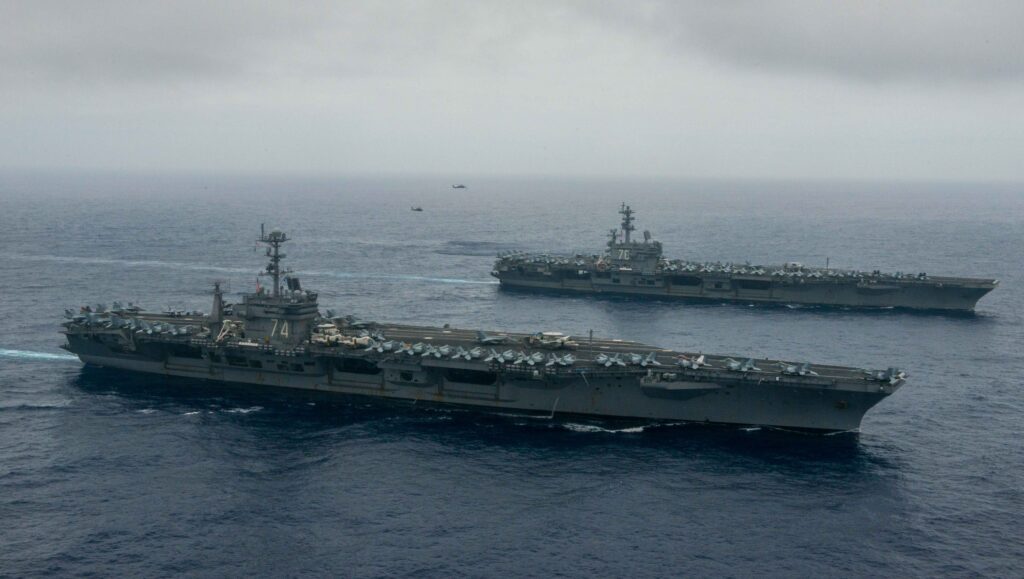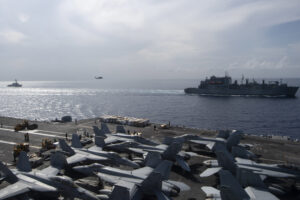
The Nimitz-class aircraft carriers STENNIS (foreground) and REAGAN (background) operate together in the Pacific.
WASHINGTON: The Navy would be forced to delay refueling of at least one aircraft carrier if Congress ends up funding the Defense Department through a Continuing Resolution on Oct. 1, a move that could crimp the service’s plans for a series of rapid and more unpredictable deployments.
Even a short CR to fund the Pentagon in place of a fully enacted fiscal year 2020 appropriations bill would affect the mid-life refueling of the USS John C. Stennis, and a longer CR is likely to hurt work on the USS Harry S. Truman, a Navy official confirmed.
The stress the carrier fleet is under is evident off the East Coast of the United States, where the Truman is working up for a new deployment just seven months after returning from a complex mission that took it from the Persian Gulf to the Arctic. The ship is filling in for the USS Dwight D. Eisenhower, which remains in port in Norfolk because its own repair availability has stretched from six months to 19 months, forcing the Truman to take over the ‘IKE’s’ deployment.

The Truman Carrier Strike Group preparing for a deployment later this year.
As Congress negotiates with the White House to reach a grand bargain on the debt ceiling and avoid a return to federal budget caps, the possibility of a CR at the start of the 2020 budget year is a real possibility — one the Pentagon has started planning for.
Under a CR, the armed services are unable to fund new start programs, a prohibition that directly impacts the midlife refueling of nuclear-powered aircraft carriers.
The Navy requested $648 million for the refueling and complex overhaul (RCOH) of the Stennis in 2020, while another $17 million has been budgeted to begin preparing for the Truman’s RCOH in 2024. The Stennis, which pulled into Newport News in May, is waiting on work to wrap up on the USS George Washington before it can begin its overhaul and refueling in 2021. The Truman, which the Navy unsuccessfully proposed mothballing early by forgoing its RCOH, will follow on the Stennis.
But before either of those efforts can kick off, contracts have to be signed and schedules made over the next several months to line up the parts and materials needed for the work to take place.
Since no contract negotiations between the government and industry can happen until an appropriations bill is signed into law, “even a CR for a few months has a significant effect,” said Thomas Callender, a naval warfare expert at the Heritage Foundation. “Therefore for a three month CR, it could delay the state of maintenance six months or more,” he added.
And if Stennis is delayed, “then Truman will be delayed in starting, since all RCOHs are conducted in the same drydock,” in Norfolk, Va., Callender pointed out.
Even without a full-year budget however, Congress can throw the Navy’s carriers a lifeline. In 2013, the Hill granted the Navy an exception for starting its RCOH on the USS Lincoln while operating under a CR.
Navy spokesman Lt. Benjamin Anderson declined to speculate on what might happen under a CR, saying “it’s Navy policy not to comment on any pre-decisional legislation. We will have those discussions at the appropriate time if and when a budget is passed.”
The Navy is looking to get a new class of frigates in the water as soon as possible, but the budget wrangling between Congress and the White House might mean that gets put on hold.
The USS George Washington, when it leaves its own RCOH in 2021, will essentially replace Truman in the rotation.
Other Navy maintenance issues could be made worse by a CR. Up to 70 percent of the service’s destroyer fleet is late wrapping up their own pier-side repair visits, and leaders have recently curtailed the flying hours for rotary and fixed wing pilots at some bases on the East Coast due to budget shortfalls.
The mid-life refueling work on carriers lasts longer, and is far more complex than other repair work the Navy undertakes, and the importance of getting carriers into their scheduled maintenance on time is reflected in the delay in getting the Eisenhower out to sea, and forcing the Truman to step in to fill the gap.
